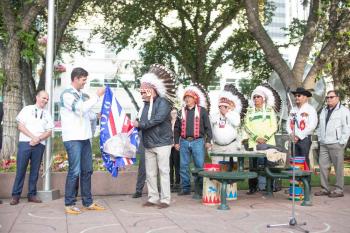Image Caption
Summary
By Shari Narine
Windspeaker.com Contributor
EDMONTON
The word “reconciliation” was used liberally as Edmonton city council voted to permanently fly both the Treaty 6 and the Métis Nation of Alberta flags at city hall on March 21.
It was the right decision to make, said Assembly of First Nations Regional Chief Craig Mackinaw.
And a long time in coming. He says he remembers the discussions occurring four or five years ago when he was Treaty 6 grand chief.
“I’m glad that they’re doing that,” he said. “It signifies that now they realize they’re in Treaty 6 territory and honouring us in our area.”
The decision to fly the two new flags alongside flags for the city, Alberta and Canada, was not unanimous.
Councillor Michael Oshry believes that because treaties were not signed with the municipal government, the flags should not be flown at city hall.
“I do see a separation on the official government flags for the city, the province and the country flying at city hall versus these ones,” he said. “I think there’s lots of things we can do, but I’m not sure this is the right way to do it.”
Oshry cast the only dissenting vote. Mayor Don Iveson and Councillor Tony Caterina were both absent.
The motion was put forward by Councillor Bev Esslinger, who was tasked with examining whether to create a new city flag that would recognize Edmonton’s Indigenous history. It was an issue raised by Iveson last November.
“In light of that, this is one way we can acknowledge the history and our commitment to making a difference in our community and reaching that reconciliation,” she said. “This is, for me, a symbolic gesture but one I think has great meaning in all nations and I think it’s important for us to take the leadership in this realm.”
Other municipalities across Canada fly Indigenous flags permanently at their buildings, she added.
Councillor Scott McKeen, who along with Iveson and Caterina, sits on the council Indigenous initiative, agreed that flying the flags was an important symbolic gesture and at a small price tag.
“I figure it is the goal of this city, with soon to be the largest urban Indigenous population, to make them feel part of and not just part of our city today but our future. We have aspirations to make this the most welcoming and inclusive city in Canada,” he said.
Councillor Michael Walters said that while the provincial government could be lobbied to also raise flags for Treaty 6 and the MNA, it wasn’t time to be “nit-picking” jurisdiction but to take a leadership role.
Mackinaw says he would like to see other municipalities in Alberta follow in Edmonton’s footsteps and raise Treaty 7 and Treaty 8 flags along with the Treaty 6 flag. He also supports council’s second motion, which is to send a letter to the province saying the flags also need to be flown at the Alberta Legislature.
“It would be a good start, especially when they talk about other things like the (Truth and Reconciliation Commission’s) recommendations and the (United Nations) declaration (on the Rights of Indigenous Peoples). It falls in line with those,” he said.
In the past, Edmonton, like other municipalities in Alberta, flew the Treaty 6 and MNA flags during weeks which honoured those specific Indigenous groups.
There was no time set for installing the two new flag poles or raising the flags.

